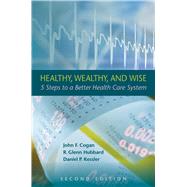
Note: Supplemental materials are not guaranteed with Rental or Used book purchases.
Purchase Benefits
What is included with this book?
| Preface to the Second Edition | p. ix |
| Acknowledgments | p. xiii |
| Introduction | p. 1 |
| The Challenge: Obtaining High-Quality, Affordable Health Care | p. 9 |
| The Good: Innovation | p. 9 |
| The Bad: High Costs and a Large Uninsured Population | p. 14 |
| High Costs: No Easy Answer | p. 14 |
| The Uninsured Population: Many Causes, Uncertain Consequences | p. 19 |
| The Ugly: Backlash against Markets and the Misguided Policy Response | p. 23 |
| The Backlash against Markets | p. 24 |
| The Misguided Policy Response | p. 25 |
| Five Policy Reforms to Make Markets Work | p. 31 |
| Increase Individual Involvement in Health Care Decisions | p. 33 |
| In Private Markets, Reform Taxation of Health Spending | p. 34 |
| Increase Cost Sharing in Government Programs | p. 49 |
| Deregulate Insurance Markets and Redesign Medicare and Medicaid | p. 52 |
| Deregulate Insurance Markets | p. 52 |
| Redesign Medicare and Medicaid | p. 63 |
| Expand Provision of Health Information | p. 66 |
| Control Anticompetitive Behavior | p. 67 |
| Reform the Malpractice System | p. 69 |
| Study the Tax Preference for Nonprofits | p. 74 |
| Impacts of Proposals on Health Care Spending, the Uninsured, the Federal Budget, and the Distribution of Tax Burdens | p. 77 |
| Effects of Reforms on Health Care Spending | p. 78 |
| Tax Deductibility | p. 79 |
| Tax Credit | p. 81 |
| Insurance-Market Reform | p. 81 |
| Malpractice Reform | p. 82 |
| Summary and Discussion | p. 82 |
| Effects of Reforms on the Number of Uninsured | p. 84 |
| Tax Deductibility | p. 85 |
| Tax Credit | p. 85 |
| Insurance-Market and Malpractice Reforms | p. 85 |
| Summary and Discussion | p. 86 |
| Effects of Reforms on the Federal Budget | p. 88 |
| Tax Deductibility | p. 88 |
| Tax Credit | p. 90 |
| Insurance-Market and Malpractice Reforms | p. 90 |
| Subsidy for the Chronically Ill | p. 90 |
| Summary and Discussion | p. 92 |
| Distributional Impact | p. 93 |
| Conclusion | p. 97 |
| Estimating the Impact of Policy Reforms on Health Care Spending | p. 107 |
| Estimating the Impact of Policy Reforms on Uninsurance | p. 117 |
| Derivation of the Elasticity of Total Health Care Spending with Respect to the After-Tax Price of Out-of-Pocket Spending | p. 121 |
| Estimating the Impact of Policy Reforms on the Federal Budget | p. 125 |
| Notes | p. 133 |
| About the Authors | p. 147 |
| About the Hoover Institution's Working Group on Health Care Policy | p. 149 |
| Index | p. 151 |
| Table of Contents provided by Ingram. All Rights Reserved. |
The New copy of this book will include any supplemental materials advertised. Please check the title of the book to determine if it should include any access cards, study guides, lab manuals, CDs, etc.
The Used, Rental and eBook copies of this book are not guaranteed to include any supplemental materials. Typically, only the book itself is included. This is true even if the title states it includes any access cards, study guides, lab manuals, CDs, etc.
“In our view,the argument for increased public intervention is seriously flawed. . . . The unintended consequences of a handful of long-standing public policies are in large part responsible for the problems of the health care system.”—Introduction, pg. 4